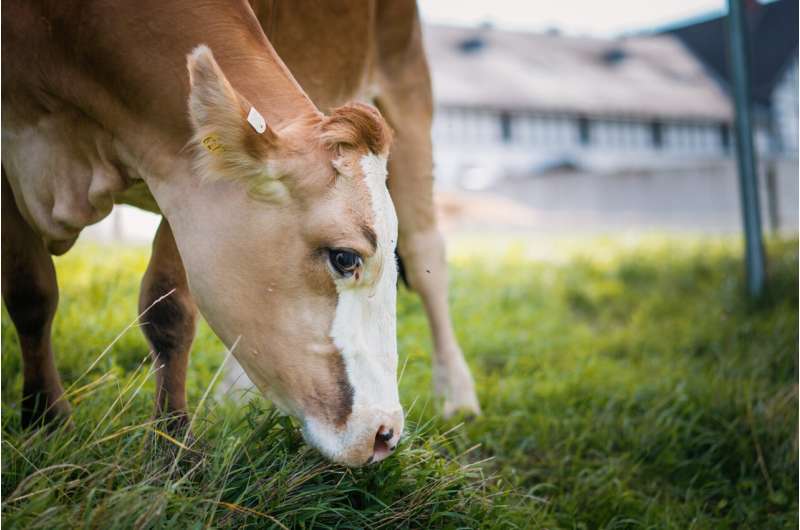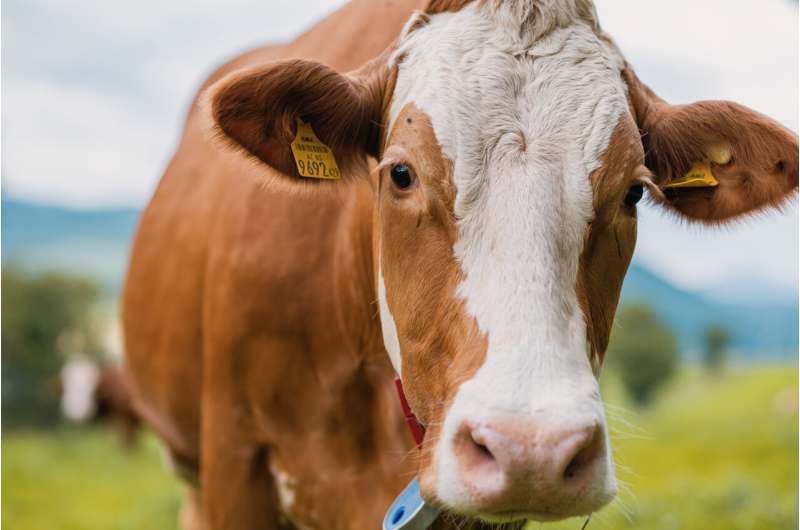This article has been reviewed according to Science X's editorial process and policies. Editors have highlighted the following attributes while ensuring the content's credibility:
fact-checked
peer-reviewed publication
proofread
Isolating and genotyping Leptospira bacteria for the first time in Austria

Leptospirosis is a globally distributed infectious disease that affects both animals and humans. While the infection is endemic in tropical regions, its incidence seems to increase in temperate regions. The serological diagnostic test used in routine to detect antibodies against the bacteria responsible for the disease performs better when local variants are used. In Austria, however, no locally circulating strain has been available to date.
A new study published in the latest issue of Scientific Reports, has now been able to close this research gap.
"In our study, we show that cattle on Austrian farms can carry the bacteria Leptospira and can be a source of infection for other animals, but also for humans or the environment," says epidemiologist and CSH researcher Amélie Desvars-Larrive.
Genetic analysis revealed that the variant found in Austria called Leptospira borgpetersenii serogroup Sejroe serovar Hardjobovis, is extremely adaptable, as it can be found in many places, in domestic and wild ruminants, as well as humans. This emphasizes the potential zoonotic risk, especially in settings where there is close interaction between humans and animals, according to Desvars-Larrive.
"The identified strain is widespread in parts of Europe and North America and has already been detected in various wild and farm animals as well as in humans," explains Desvars-Larrive, leading author of the study who also works at the University of Veterinary Medicine, Vienna (Vetmeduni).
"At present, Austria uses strains from abroad to diagnose the disease in humans and animals. It will now be possible for the national laboratory to use this new strain," points out the epidemiologist. "In other words, the test performance will be improved when using the local strain."
Field work
The search for the pathogen in Austria was anything but easy, says Desvars-Larrive. For 2021 and 2022, the epidemiologist and her colleagues from the CSH, Vetmeduni, and Austrian Agency for Health and Food Safety (AGES) conducted targeted sampling to maximize their chance of isolating the bacteria in a non-endemic country. They used statistical methods, a literature review, and a farm network to search for infected animals.
"Samples were taken from 410 cattle," says the epidemiologist. "Five of them tested positive for leptospirosis. The bacteria were successfully isolated, cultivated, and precisely identified three times."

And lab work
The team also faced a number of challenges during the characterization process. "The cultivation of Leptospira is very challenging and time-consuming. Samples had to be in the laboratory (AGES Mödling) within two to six hours. The bacteria needed a complex medium in which antibiotics specifically protected them from contamination by other bacterial strains," points out Cynthia Sohm from Vetmeduni, the first author of the study.
"Samples had to be cultivated for between seven and 23 weeks before the bacteria could be observed." Additionally, the presence of the bacteria in samples was verified using a PCR test, adds Sohm.
Lastly, the pathogen was isolated from successful cultures and genotyped at the Institut Pasteur in Paris. "Certain parts of the genetic material were sequenced so that the bacterial strain could be precisely characterized," explains Desvars-Larrive.
Austria and Europe
In her opinion, the study raises awareness of leptospirosis' dangers. Compared to tropical areas where infection frequency and severity are much higher, Austria has so far considered the disease relatively harmless. "But with global warming and associated flooding events, it is becoming increasingly common in temperate countries, including in urban areas," warns the epidemiologist. "This means that the risk of infection may also increase in Europe in the future."
As Desvars-Larrive points out, leptospirosis poses a public health problem for both humans and animals. In cattle, leptospirosis can lead to fertility problems and reduced milk production, making the disease economically relevant as well, adds the epidemiologist.
Using an integrated approach is an effective way to prevent infection on farms, says Desvars-Larrive. "In particular, through enhanced biosecurity measures and management of environmental reservoirs. Rats and other rodent populations, which are considered maintenance hosts for the bacteria, must be reduced as much as possible. If the infection is diagnosed in the livestock, antibiotics can also be used for treatment."
A devastating disease
Globally, leptospirosis kills over 50,000 people a year and infects over 1 million, according to the US Centers for Disease Control and Prevention. It is the most common zoonotic infection—a disease that can naturally be transmitted between humans and animals—in the world.
The disease is usually spread by direct contact with infected animals' urine, or by coming into contact with contaminated soil or water. Most mammalian species, wild and domestic, can be infected with Leptospira and potentially transmit leptospirosis, including rodents, cattle, pigs, and dogs.
In humans, it can cause a variety of symptoms, from mild, flu-like syndrome, mimicking other diseases, to a severe form called Weil´s disease. Leptospirosis can lead to kidney damage, meningitis, liver failure, respiratory distress, and even death without treatment.
More information: Cynthia Sohm et al, First isolation and genotyping of pathogenic Leptospira spp. from Austria, Scientific Reports (2024). DOI: 10.1038/s41598-024-53775-w
Journal information: Scientific Reports
Provided by Complexity Science Hub



















